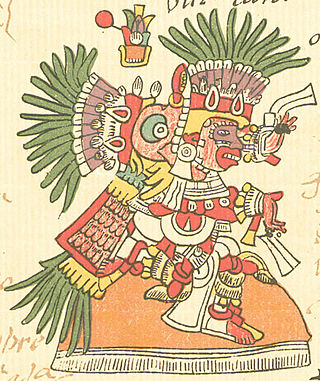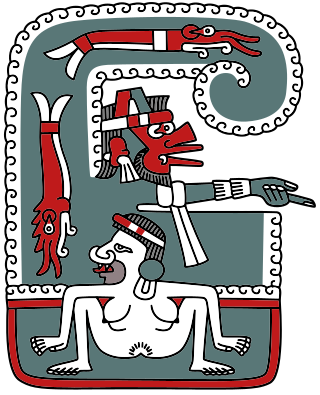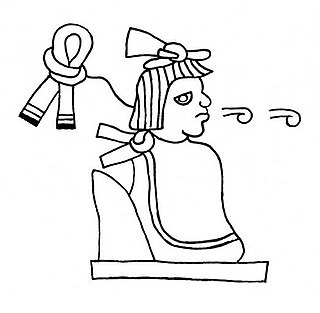Related Research Articles
Year 1397 (MCCCXCVII) was a common year starting on Monday of the Julian calendar.

Year 1427 (MCDXXVII) was a common year starting on Wednesday of the Julian calendar.

Tlāhuizcalpantēcuhtli is a principal member of the pantheon of gods within the Aztec religion, representing the Morning Star Venus. The name comes from the Nahuatl words tlāhuizcalpan "dawn" and tēcuhtli "lord". Tlahuizcalpantecuhtli is one of the thirteen Lords of the Day, representing the 12th day of the Aztec trecena.

In Aztec mythology, Tonacatecuhtli was a creator and fertility god, worshipped for populating the earth and making it fruitful. Most Colonial-era manuscripts equate him with Ōmetēcuhtli. His consort was Tonacacihuatl.
Tlillan-Tlapallan 'Place of the black and red colour' is a legendary place or region on the Gulf Coast of Mexico where king Quetzalcoatl went on his flight from Tollan in order to burn himself and change into the Morning Star.

Chimalman or Chīmalmā /t͡ʃiːmalmaː/ is a goddess in Aztec mythology, and was considered by the Aztecs to be the mother of the Toltec gods Quetzalcoatl and Xolotl. Her name means "shield-hand."

Entoku (延徳) was a Japanese era name after Chōkyō and before Meio. This period spanned the years from August 1489 through July 1492. The reigning emperor was Go-Tsuchimikado-tennō (後土御門天皇).

Huitzilihuitl or Huitzilihuitzin was the second Tlatoani or king of Tenochtitlan. According to the Codex Chimalpahin, he reigned from 1390 to 1415, according to the Codex Aubin, he reigned from 1396 to 1417 and according to the Codex Chimalpopoca, he reigned from 1403 to 1417.

Chimalpopoca or Chīmalpopōcatzin (1397–1427) was the third Emperor of Tenochtitlan (1417–1427).

Maxtla was a Tepanec ruler (tlatoani) of Azcapotzalco from 1426 to his death in 1428.
Faustino Galicia Chimalpopoca or Faustino Chimalpopoca(tl) Galicia was an indigenous Mexican lawyer, professor, translator, and administrator.
Chimalpopoca may refer to:
Tezozomoctli (1406–1483) was the tlatoani (ruler) of Tizic, a subdivision of the pre-Columbian Nahua state of Cuitlahuac, from the year 1 Reed (1415) until his death in the year 4 Reed (1483).
"The Stinking Corpse" is an Aztec myth that tells of the body of a giant, killed by the Toltecs, which released a stench that would kill anyone who smelled it. Versions of it are recorded in the Legend of the Suns, the Anónimo Mexicano, Torquemada's Monarchia Indiana, and elsewhere.
Tlaltecatzin, according to some sources, was a son of the Aztec tlatoani Moctezuma II. In the Noche Triste, the Spanish took him out of Tenochtitlan as a prisoner with other Aztec noblemen, also prisoners, including his brother Chimalpopoca. The Aztecs attacked the Spanish party, and both Tlaltecatzin and Chimalpopoca were killed.
Kriimi laid is an island belonging to the country of Estonia.
Tayatzin was a king of Tepanec city of Azcapotzalco in Mexico. He is also called Quetzalayatzin.
Events from the year 1517 in India.
Codex Chimalpopoca or Códice Chimalpopoca is a postconquest cartographic Aztec codex which is officially listed as being in the collection of the Instituto Nacional de Antropología e Historia located in Mexico City under "Collección Antiguo no. 159". It is best known for its stories of the hero-god Quetzalcoatl. The current whereabouts of the codex are unknown. It appears to have been lost in the mid-twentieth century. Study of the codex is therefore necessarily provided only through copies and photographs. The codex consists of three parts, two of which are more important, one that regards the pre-Hispanic history of Central Mexico, the Anales de Cuauhtitlan and the other that regards the study of Aztec cosmology, the Leyenda de los Soles.
Xihuitl Temoc, alternatively rendered as Xihuitl-Temoc and Xihuitltemoc, was, according to the Crónica Mexicayotl, the last king or tlatoani of Tenochtitlan before the formation of the Aztec Empire.